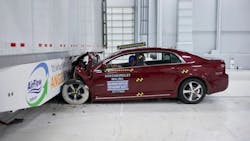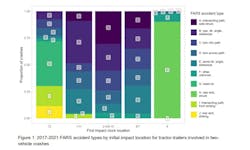The Insurance Institute for Highway Safety (IIHS) critiqued a National Highway Traffic Safety Administration (NHTSA) study on underride guards for large trucks, stating that the administration underestimated the amount of lives the guards could save. In a regulatory comment posted by the institute, the organization noted several points where they believe the study was lacking and proposed an alternative approach with higher results.
“Specifically, we estimate the number of lives that could be saved by a side underride guard standard is up to ten times the number reported by NHTSA,” said Matthew Brumbelow, senior research engineer, IIHS, in his response to NHTSA’s request for comment on its advance notice of proposed rulemaking (ANPRM) regarding an underride guard mandate.
While there is no current requirement for side underride guards on tractor-trailers, NHTSA is currently considering mandating the safety measures to prevent underride crashes, or when a passenger vehicle passes beneath a tractor-trailer chassis. In the ANPRM, NHTSA reported that mandatory underride guards could save 17 lives and prevent 69 serious injuries annually.
Read more: NHTSA raises potential side underride guard mandateIn response, Brumbelow stated that the NHTSA study was overly restrictive in the criteria it used to identify fatal crashes, that it didn’t accurately establish when underride occurred in accidents, and that it did not represent the efficacy of underride guards at certain speeds.
On a granular level, Brumbelow stated that using Fatality Analysis Reporting System (FARS) data and a previous IIHS Large Truck Crash Causation Study (LTCCS) from 2012, the organization could better account for underride crashes involving more than two vehicles. Additionally, Brumbelow argued that the NHTSA should have used expanded crash codes beyond those for front or roof impacts, as FARS data reported that 14% of passenger vehicle fatalities coded their initial crashes as side or rear impacts. Nor could the NHTSA ignore crashes that occurred between 1-11 o’clock and 5-7 o’clock zones on semi-trucks, the IIHS researcher stated.
Due to these factors, Brumbelow noted that several of the incidents included in FARS data would not be accounted for in NHTSA’s study.
“In other words, two-thirds of the fatalities attributed to trailer side underride would not even show up in NHTSA’s ‘target population’ for a side underride guard rule,” Brumbelow said.
He also criticized the NHTSA study for failing to account for pedestrian, bicyclist, and motorcyclist deaths in their research, not using photographic evidence, and in working off the assumption that underride crashes did not occur in accidents unless otherwise stated, instead of the other way around.
“In our comprehensive review of LTCCS, underride occurred in 56 of 78 (72%) semi-trailer side crashes in which the most severe injury was attributed to the trailer impact,” Brumbelow explained. “This included 25 of 28 (89%) cases producing a serious or fatal injury. In their analysis of a subset of LTCCS cases, Blower and Woodrooffe (2013) found that underride occurred in 42 of 59 (71%) trailer side impacts, without accounting for injury occurrence.”
Brumbelow further argued that NHTSA’s data did not do its utmost to accurately understand the speeds at which underride crashes occurred and that underride guards could prevent, data which the IIHS stated could be obtained with Event Data Recorder (EDR) delta-V information. Finally, Brumbelow also stated that the NHTSA’s assumption that underride guard efficacy is limited to speeds of 40 miles per hour was incorrect.
“NHTSA chose this cutoff speed based on one 40 mi/h IIHS test of an aftermarket side underride guard manufactured by AirFlow Deflector,” Brumbelow noted in his commentary. “In this crash test, the guard prevented underride of a midsize sedan striking perpendicularly near the center of the trailer.”
As an alternative to these results, the IIHS said that it used the analysis from its LTCCS study combined with FARS data to understand how many passenger vehicle occupant fatalities could be avoided with standardized underride guards. The agency did this by matching all LTCCS cases that resulted in a fatality with FARS records, selected the cases where FARS reported a semi-trailer with initial impacts in locations 1-5 o’clock and 7-11 o’clock, and then determined how many of these passenger vehicle fatalities resulted from side underride impacts.
As a result, the IIHS found that elevated results from those of the NHTSA study.
By applying these proportions to FARS data from 2017-2021, which Brumbelow’s commentary said indicated that 549 passenger vehicle fatalities per year involved crashing into the side of a tractor-trailer, the IIHS argued that 159-217 lives could be saved with an underride guard standard, depending on how far it extended.
As a result, Brumbelow appealed to the agency to do a more thorough analysis of how useful underride guards could be in roadway safety and gave his support to the underride guard mandate.
About the Author

Alex Keenan
Alex Keenan is an Associate Editor for Fleet Maintenance magazine. She has written on a variety of topics for the past several years and recently joined the transportation industry, reviewing content covering technician challenges and breaking industry news. She holds a bachelor's degree in English from Colorado State University in Fort Collins, Colorado.




